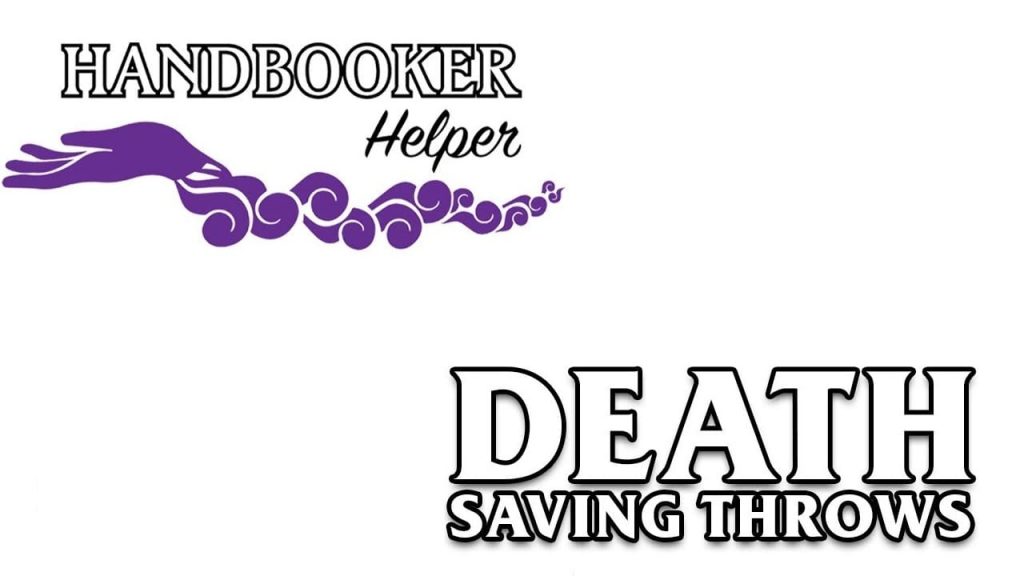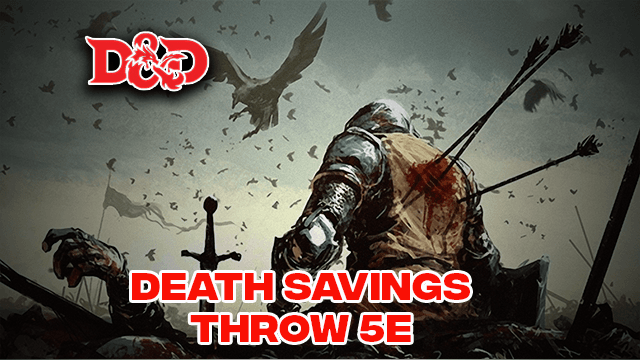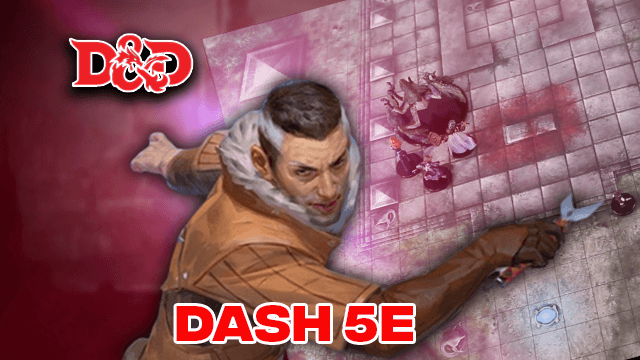Death Saving Throw 5e | D&D 5th Edition – Saves Guide (2023)
As you might have guessed by now, death saves 5e refers to a death saving throw that you use when your character is on the verge of death. It’s a roll that determines whether your character would die or not. As soon as your player attains 0 hit points, he falls unconscious and begins throwing death saves. You can find its definition on pg. 197 of the Player’s Handbook.
Table of Contents
How do death saves work 5e?
Here’s how to throw a death save.
What happens when you succeed death saves?
When your character loses consciousness, roll a d20 dice on your next turn. Keep in mind that this roll is against the death save Difficulty Class (DC) which is at 10. So if you roll more than 10, you succeed on 5e death saves, but if you roll less than that, it’d be a failure. However, the odds would be on your side mostly as there’s a 55% chance of success.
Once you succeed 3 times, your character would become stable. They won’t regain consciousness and would still have 0 hit points, but they won’t have to use more saving throws.
What happens if you fail three death saves?
If you fail thrice, your character dies.
If you’re lucky enough, you might roll a natural 20 on a d20 dice, which would make your player stable; they’d acquire 1 hit point and become conscious. But, if you roll a natural 1, you’d inevitably fail on two death saves.
How do you make a death saving throw 5e?
Damage at o Hit Points – If you take damage during 0 hit points, for instance, then also it’s considered a death-saving throw failure. In the case of damage due to a critical hit, it’d count as two failures, and if the damage is equal to or more than your highest hit point, you’d instantly die.
Another bonus point of this feature is that you don’t have to succeed consecutively. You only need victories, which you can win throughout 6 rolls, at most.
Also, death saves aren’t ability checks because you need to check for this to work. Six ability scores and their modifiers are used for regular saving throws but not for death saving throws.
Death saves don’t use a constitution modifier or a Swim speed 5e check modifier. They’re just d20 rolls against DC 10.
In the Tomb of Annihilation, the “Meat Grinder Mode” rules set the death save to DC 15. Due to this, your chances of survival reduce from 60% to 26%.

Advantage and disadvantage on death saving throw 5e
Since DnD 5e death saves are a type of saving throw, any spell or feature that offers them an advantage or disadvantage also does the same for death saving throws.
So if your probability to succeed was 55%, it reaches you to 75% with an advantage. However, death saves don’t possess an Ability Score; therefore, an advantage on an ability check or saving throw won’t benefit them. You can have these advantages on death saves only or on saving throws, in general.
There are some other setbacks as well like –
Being unconscious
- These creatures are indisposed, and they can’t speak, move, and are oblivious of their surroundings.
- Whatever the creature is holding falls to the ground, and they drop prone.
- They fail their Dexterity saving throws and Strength.
- Any attacks rolls against the creature are successful.
- It’d be considered a critical hit if the opponent is within a 5 ft. range of the target and attacks.
Prone
- If a creature’s prone, it can only crawl until they stand up and end the condition.
- They’d have a disadvantage on attack rolls.
- An attack roll will have an advantage if the enemy is within 5 ft. Otherwise they’d have a disadvantage.
Incapacitated
- Such a creature can’t take a reaction or action.
Spells and class features
If you’re looking for a loophole that would ensure that you don’t fail death-saving throws, then you’re at the right place. So here are a few alternatives you can use to make this happen.
- Spare the dying – To reset death saves, you can use the “Spare the dying” feature under Cleric, according to which if you touch a breathing creature with no hit points, they will become stable (pg. 277 of PHB). However, it wouldn’t work on undead or constructs. Once your player is stable, their death save count renews.
- Jack of all trades – You can’t utilise Jack of all trades, a 2nd level feature for Bards on death saves, unfortunately. This attribute mentions that you can incorporate half of your proficiency bonus to any ability check, which doesn’t include a proficiency bonus already (PHB pg. 54). However, death-saving throws aren’t ability checks, as mentioned earlier.
- Bardic inspiration – Another feature for the bards which would offer you or the creature an extra d6 dice. As stated on PHB’s pg. 53, within the subsequent 10 minutes, the player can roll the dice once and add the number to an attack roll, ability check, or saving throw it uses. Since death saves come under saving throw, you can utilise it.
- Bane – This is also an attribute that you can use on death-ssaving throws. It’s a 1st level spell according to which, whenever a player fails the death save by making a saving throw or attack roll before the spell ends, they must roll a d4 and deduct that number from the saving throw or attack roll (PHB pg. 216). Now death saves are a kind of saving throw; this feature works.
- Bless – It works oppositely as bane because the target includes a d4 in their attack roll or saving throw itself. Concentration is the key in both cases, as they’d stay active as long as the spellcaster remains focused.
- Lucky – According to pg. 167 of PHB, whenever you use an attack roll, saving throw, or ability check, you’d acquire one lucky point, which would enable you to roll another d20. So yes, you can use this on death-saving throws to avoid failing.
Coup de Grâce mechanism
Here are a few rules of this mechanism –
- To attack a lifeless creature, you need to roll.
- When you do hit them, you’ll deal a critical hit.
- Attacks close to you have the upper hand.
- The attacks made at a range are regular. However, they’d have a disadvantage if you’re prone, whereas it’d be advantageous when you can’t see.
How to make death saves exciting?
There are ways to make a death save more fun and interesting like –
Hidden death saving throws
DMs should incorporate the option of hidden death saves, which is especially beneficial during virtual gaming. The player can secretly roll a virtual or physical dice and then send the DM a private message about the result.
In the case of physical gaming, the player can go behind the DM screen and roll. Do tell if it’s a natural 1 because that leads to two failures, so your team needs to that they have to revive you quickly.
A throw right off the jump
Another thing that the DM can do is make a house rule according to which, whenever a creature reduces to 0 HP, they must make an initial death save roll. This would ensure that there are fewer chances of failing or a natural 1.
Another good thing that comes out of it is that you don’t have to wait for a conclusive round. For instance, if you get 0 saves and 1 saves or 1 and 0 or 1 and 1, it’d be inconclusive. But if you use this rule, things would speed up.
Give em a snack
There’s nothing wrong with this rule, as stated by D&D 5e RAW. According to standard instructions, if the opponent is within 5 ft. of the target and attacks, it’d be a critical hit and lead to two failures. But if the damage is equal to, or more than the creature’s HP, it means instant death.
So with this alternative, if a Dark Knight saw the Wizard reviving from O HP and roll with an advantage and hits the unconscious Wizard, they’d need quick medical attention. However, things might turn if the barbarian, paladin, or rogue interfere in between and defend the knight.
To avoid such tense situations, you can hit an AOE damage, a magic missile, or a rogue arrow that wouldn’t be a critical hit and lead to only one failure.
Is death saving throw an action?
No, a death-saving throw isn’t an action because, according to pg. 290 of PHB, when a creature is indisposed, they can’t take action or reaction. This includes the bonus action as well. Even if you have a feature that allows you to use an extra action, it won’t be compatible with D&D 5e death saves.







